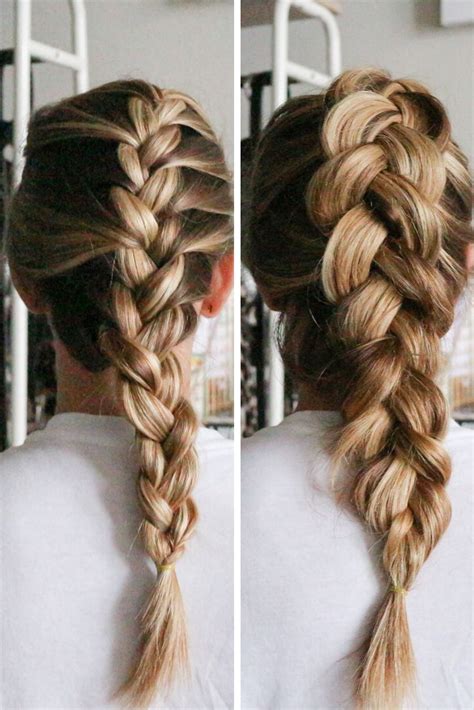Introduction
Braids have been a timeless trend, gracefully adorning heads for centuries. Among the plethora of braiding techniques, French and Dutch braids emerge as two captivating choices. While sharing a deep-rooted history and braiding principles, they weave a distinct charm with their subtle nuances. This article delves into the intricate details of French and Dutch braids, unveiling their unique characteristics, step-by-step instructions, and practical applications.

Understanding French and Dutch Braids
1. Origin and History
French braids, also known as French plaits, originate from France, popularized in the 19th century. Dutch braids, on the other hand, have their roots in the Netherlands, gaining prominence in the 17th century.
2. Weaving Technique
Both French and Dutch braids employ a three-strand plaiting technique. However, a key difference lies in how the strands are incorporated:
- French Braid: Strands are woven over one another, creating a raised, elegant braid that rests on top of the head.
- Dutch Braid: Strands are woven under one another, resulting in a flatter, more intricate braid that sits closer to the scalp.
3. Visual Appearance
The telltale sign of a French braid is its intricate, ladder-like pattern that emerges due to the overhand weaving technique. Dutch braids, with their underhand weaving, exhibit a more compact, flatter appearance with more defined sections.
Step-by-Step Braiding Techniques
1. French Braid
- Brush your hair thoroughly to remove tangles.
- Divide your hair into three equal sections at the crown.
- Cross the right and middle strands over the left strand.
- Add a small portion of hair from the right side and cross it over the middle strand.
- Repeat Step 4 with the left side, alternating between sides and incorporating additional hair.
- Continue braiding until you reach the nape of your neck.
- Secure the braid with an elastic band.
2. Dutch Braid
- Prepare your hair as in French braiding.
- Divide the hair into three sections.
- Cross the left and middle strands under the right strand.
- Add a small portion from the left side and cross it under the middle strand.
- Repeat Step 4 with the right side, alternating and adding hair.
- Continue braiding until the end of your hair.
- Secure the braid with an elastic band.
Practical Applications
1. Everyday Hairstyles
Both French and Dutch braids offer versatile styling options for everyday wear. They are perfect for keeping hair off the face and adding a touch of charm to any outfit.
2. Special Occasions
French and Dutch braids elevate the elegance of special occasions such as weddings, proms, and formal events. They can be incorporated into intricate updos or serve as statement braids.
3. Hair Extension Integration
French and Dutch braids can be used to seamlessly integrate hair extensions, creating a natural and voluminous look.
4. Headbands and Jewelry
French and Dutch braids can be adorned with hair accessories such as headbands, clips, and beads for a unique and stylish touch.
| Feature | French Braid | Dutch Braid |
|---|---|---|
| Weaving Technique | Strands woven over one another | Strands woven under one another |
| Appearance | Raised, ladder-like pattern | Flatter, more intricate pattern |
| Braiding Direction | From the outside in | From the inside out |
| Final Placement | Rests on top of the head | Sits closer to the scalp |
| Braiding Technique | French Braid | Dutch Braid |
|---|---|---|
| Step 1 | Divide hair into three sections | Divide hair into three sections |
| Step 2 | Cross right over middle | Cross left under middle |
| Step 3 | Add hair from right side | Add hair from left side |
| Step 4 | Repeat steps 2-3 | Repeat steps 2-3 |
| Step 5 | Secure with elastic band | Secure with elastic band |
| Practical Application | French Braid | Dutch Braid |
|---|---|---|
| Everyday Hairstyles | Yes, versatile for everyday wear | Yes, suitable for everyday hairstyles |
| Special Occasions | Yes, adds elegance to formal events | Yes, creates intricate updos |
| Hair Extension Integration | Seamlessly integrates extensions | Blends extensions naturally |
| Headbands and Jewelry | Can be adorned with accessories | Can be embellished with accessories |
| Tips and Considerations | French Braid | Dutch Braid |
|---|---|---|
| Hair Texture | Suitable for all hair types | Works best on thicker hair |
| Hair Preparation | Brush thoroughly to remove tangles | Section and comb through hair |
| Braiding Tension | Keep an even tension throughout | Use firm tension for a more defined braid |
| Braiding Angle | Keep braid slightly elevated | Maintain a horizontal angle |
| Practice | Regular practice perfects technique | Consistent practice ensures proficiency |
Innovation: Braided Utility Garments
1. Braided Cooling Vests
Dutch braids can be strategically placed on vests, creating intricate ventilation channels that effectively dissipate body heat.
2. Braided Athletic Wear
French braids can be incorporated into sportswear, providing support and reducing friction during intense activities.
3. Braided Backpack Straps
French and Dutch braids can be used to create comfortable and stylish backpack straps that distribute weight evenly.
4. Braided Home Decor
Braided rugs, pillows, and curtains add a touch of texture and warmth to home environments.
Conclusion
French and Dutch braids are timeless braiding techniques that have stood the test of time. While both create beautiful and versatile hairstyles, their subtle differences in weaving and appearance make them unique. Understanding their nuances and mastering the step-by-step instructions empowers individuals to craft these braids with ease. Embracing the creative possibilities of braided utility garments further demonstrates the versatility and practicality of these braiding masterpieces. As individuals continue to explore the world of braids, they will undoubtedly uncover new and innovative applications, ensuring these techniques remain a vibrant part of our hairstyling culture.
